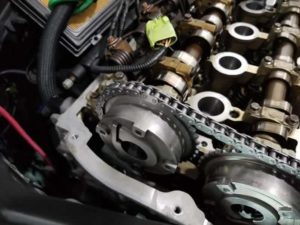Timing chain: explanation, advantages, disadvantages and problems
The timing chain ensures that the piston, crankshaft and valves, including the camshaft, work together in harmony. It transfers the rotational motion of the crankshaft to the camshafts. The timing of the opening and closing of the cylinder valves is crucial in a typical four-stroke engine. If the timing chain is stretched (or even torn), it can no longer perform this task and, in the worst case, even lead to engine damage.
If you suspect a defect, you should take immediate action and take the car to the workshop as soon as possible. On this page, background info on the timing chain and what to consider when replacing it.
What does the timing chain do?
Inhoud
Until the 1980s, only timing chains were used to transmit the rotational movement from the crankshaft to the camshaft. Today, space-saving and cheaper timing belts are often used instead of timing chains (see page timing belt replacement). Still, the timing chain by no means obsolete: the timing chain is still used today, especially in particularly powerful vehicles, as it can transmit higher forces than the plastic belt.
 The movements in an internal combustion engine must be synchronised. It can only work if each movement is properly synchronised. This is especially true for the combustion process itself: when the valves open or close and where the piston is at that moment is elementary for the engine to run.
The movements in an internal combustion engine must be synchronised. It can only work if each movement is properly synchronised. This is especially true for the combustion process itself: when the valves open or close and where the piston is at that moment is elementary for the engine to run.
The chain coordinates these processes and connects the crankshaft to the camshafts. This ensures that they run in the right proportion to each other and do not get in the way of their work. If something goes wrong, it could result in major engine damage.
How does a timing chain work?
The timing chain works in the same way as a bicycle chain: the chain transfers power from one axis to the other. The angular momentum of the crankshaft is transmitted to the camshafts through the chain links. The chain runs on sprockets in the enclosed engine. It cannot be controlled from the outside.
Depending on the manufacturer and engine, simple distribution chains (simplex chains) or double chains (duplex chains) are used. In rare cases, chains with three links connected in parallel are used (triplex chaine"), for example in old Ferrari models.
Rule of thumb: the more links, the more durable the chain - and the heavier the system.
What is the difference between a belt and chain?
A timing belt and a timing chain do the same job, the difference being that a chain is made of hard steel links and a belt is made of plastic. Although they do the same job in terms of functionality, the systems have different advantages and disadvantages.
What are the pros and cons?
 Distribution chains have been used in engine construction for more than 100 years. They can transmit large forces and are therefore especially popular with powerful engines. They can also be used to cover relatively long distances. If all parts involved are working correctly, timing chains last for many kilometres.
Distribution chains have been used in engine construction for more than 100 years. They can transmit large forces and are therefore especially popular with powerful engines. They can also be used to cover relatively long distances. If all parts involved are working correctly, timing chains last for many kilometres.
There are no fixed maintenance intervals, unlike a timing belt, making maintenance costs a lot lower.
Advantages of a timing chain
As mentioned, the biggest advantage is that a chain lasts much longer than a belt. A chain is basically designed to last a lifetime and would never need to be replaced in the most optimal case.
Disadvantages of a chain
Unfortunately, a timing chain is not indestructible and, in practice, in many cars the chain still has to be replaced. In such cases, the repair is often more expensive than replacing a timing belt. This is mainly because the chain is difficult to reach, so the garage needs more working hours to replace it.
There is also the disadvantage that if a chain breaks there will be major damage. Of course, we assume that this is not going to happen but if a chain does unexpectedly break and break loose, there is a chance that the whole block will be destroyed. This is a lot more severe than if a timing belt will break.
Timing of timing belt
On this page, more information on timing belt replacement and the corresponding intervals. We have a comprehensive database containing the intervals of various makes and models. Depending on the make and model, the belt needs to be replaced with some regularity. So when your car's timing belt needs to be replaced depends on the make and model.
For most brands, the interval is between 60 and 160 thousand kilometres. In most cases, the belt also has an age limit, 3, 5 or 10 years. Read more about timing belt replacement at this page.
Is a chain indestructible?
A chain is low-maintenance and strong as long as everything works and is well maintained but is certainly not indestructible. With age, chain links get longer, which confuses the processes in the engine. Valves open and close a little too late, the engine runs badly and consumes more. This wear can be compensated to some extent. If the chain becomes too long, it has to be replaced. In that case, continuing to drive with the chain can lead to major problems.
If the chain breaks it can mean the end of the engine which in most cases means your car is ripe for scrapping.
Manufacturers prevent stretching during use by lengthening distribution chains before installation to minimise play in the long run. There are still weaknesses: sliding and clamping rails can also wear out. This can be due to incorrect, old or insufficient engine oil, to age or to defects in the material. In all cases, the chain loses tension. This can be noticed by a rattling, clicking, scraping or scraping slightly above idle speed. At idle, this is easily noticeable at about 1,500 rpm.
Note: Not every timing chain defect is noticeable. However, many workshops recognise them using diagnostic equipment. So, when in doubt, we advise you to visit a garage.
How do you recognise a defect in the chain?
timing belts can tear, timing chains on the other hand can lengthen over time (they are then "elongated") and will no longer be tight. However, material fatigue is also conceivable in timing chains and, in rare cases, the timing chain can even tear, resulting in engine damage.
Therefore, the condition of the chain should be inspected during, for example, a major service and certainly towards the end of their expected service life.
What symptoms should you look out for?
A defect in the timing chain is not always obvious, but the following symptoms should ring a bell:
- rattling noises from the engine (possibly only on cold start). When worn, the chain will loosen, causing vibrations. This then translates into engine ticking or rattling. (Tip: read our blog about rattling noises)
- performance reduction of the engine because the chain is worn out, preventing the engine from performing optimally.
- the control light comes on. This could mean several things but could also indicate problems with the chain.
- bits of metal can be seen in the engine oil. You can see this while changing the engine oil.
Worn distribution chain
Because manufacturers generally do not specify an interval for chain replacement, you will have to be keen on a worn timing chain yourself. As indicated in the overview above, a worn timing chain can be recognised by rattling and rattling noises on the distribution side of the car engine. You can observe these noises in both a warm and cold engine.
If the chain gives way or jumps when the engine is running, I can cause major problems and damage to the engine because in that case, the pistons hit the valves. So always be keen on inspecting the chain and if in doubt about a worn chain, visit a garage near you.
When should you replace a timing chain?
 When should you make a timing chain replacement? There is no one-size-fits-all answer to this because there are different types of chains and so this varies by manufacturer and model. Distribution chains are often installed as single or duplex chains and vary greatly in durability and wear.
When should you make a timing chain replacement? There is no one-size-fits-all answer to this because there are different types of chains and so this varies by manufacturer and model. Distribution chains are often installed as single or duplex chains and vary greatly in durability and wear.
Generally, for single, simplex chains, 100,000 km is adhered to. For duplex chains, the mileage is a lot higher, every 400,000 to 500,000 km.
However, if the timing chain is already stretched or even cracked, it obviously needs to be replaced earlier. However, they often don't reach these high mileages because they are often replaced earlier during other jobs on the car. Which replacement intervals are used is determined by the manufacturer and can often be found in the service booklet.
When in doubt, you can of course always contact the specialist garage! If you hear rattling noises coming from the engine, you should always remember to inspect the timing chain and replace it if necessary. The chain should always be tight, otherwise the advice is to seek a garage quickly.
What are the costs?
For most cars: the timing chain does not need to be replaced. If a chain does need to be replaced, it can quickly become an expensive job as the chain is not in an easily accessible place on all bikes. In that case, it therefore costs labour hours, which ultimately means money. The material costs for a timing chain replacement are not high. Think about around €100. Even the complete set with clamps and rails costs only a few €100 for many models. The installation and labour hours, however, make it an expensive job.
Distribution chain replacement costs
What are the costs for a timing chain replacement? Costs range from around €800 to €1,500 depending on the model. This can sometimes be more expensive and sometimes cheaper, but keep in mind that you can easily spend more than € 1,000 for timing chain replacement. The cost depends on the make and model. In some cars, the chain is difficult to reach and the whole block has to be taken apart to replace the chain.
Want to know exactly what the cost will be? Then contact a garage. Remember that a branded dealer is often more expensive than a regular garage in your area.
What work will be carried out?
When you take the car to the garage to have the timing chain replaced, the following work is carried out:
- Draining oil and cooling water
- Removing attachments (e.g. V-belt)
- Loosen the cover of the distribution housing
- Remove chain and replace timing chain for a new one.
- Screw the cover back on, replace the attachments and fill with new(!) oil and cooling water. It is best to replace the oil filter at the same time.
Does my car have a chain?
Whether you have a timing chain can of course be checked under the bonnet yourself, although for many laymen this is still a difficult job. You should be able to find out whether your car has a chain in its service booklet. If in doubt, you can always ask a garage.
It is generally known that timing chains are a tradition at BMW and Mercedes models. But also many Kia's and some Honda's make extensive use of a chain. VW and Audi currently use timing belts in small engines, but older drives also use timing chains. A look in the service booklet often clarifies: if the timing belt does not need replacing, the car has a timing chain.
Oil change for longer life
 Perhaps needless to say but for all engines, punctual oil changes and high-quality oil are prerequisites for long engine life. If problems occur with the timing chain, manufacturers will only grant goodwill if service intervals are meticulously observed.
Perhaps needless to say but for all engines, punctual oil changes and high-quality oil are prerequisites for long engine life. If problems occur with the timing chain, manufacturers will only grant goodwill if service intervals are meticulously observed.
Known problems with the timing chain can be fixed to some extent by changing the oil earlier. While this measure increases maintenance costs, it can save a lot of money in the long run.
Known problems
Unfortunately, there are several models known to have problems with the timing chain. Below is a brief list of these car models.
1.2 & 1.4 TSI engines from Volkswagen
Volkswagen's TSI engines are wonderful engines because they deliver a lot of power at low consumption. Unfortunately, especially the widely used 1.2 and 1.4 engines from a few years back have huge problems with the timing chain.
These problems are usually caused by a malfunctioning chain tensioner. This slowly stretches the chain, causing it to loosen. This puts even more stress on the chain tensioner, eventually making it unable to hold and causing the engine to fail with a loud bang.
Toyota Aygo chain replacement (and Peugeot 107/Citroën C1)
The cars in the PSA trio Aygo, 107 and C1 (all cars from the same group) are very popular as city cars. These cars have a chain for distribution that almost never lasts longer than 80,000 km. So make sure you are on time with chain replacement and don't wait until you have a broken timing chain.
Known problems with Alfa 159
Alfa Romeo's JTS engines also regularly have problems with the distribution. As with the TSI engine, this is often not properly under tension, causing it to stretch and malfunction. Replacing the timing chain or selling the car is then often the only option.
Opel Corsa problems
The timing chain on the Opel Corsa C is also known to fail faster than Opel had planned. In theory, it should last at least 200,000 km, but there are cases where the chain jumped after 140,000 km and totaled the engine block. Therefore, as a rule, the chain on these cars is replaced preventively after about 100,000 km.
BMW timing chain
There are several BMW engines that have problems with the timing chain. In particular, these are the BMW N20B20, B48 and B38 petrol engines. In fact, engines of this type are known to have problems with the timing chain after only about 50,000 km.
Frequently Asked Questions
How long does a timing chain last? Normally between 100,000 km (simplex timing chain) and 500,000 km (duplex timing chain). However, timing chains can lengthen over time (then they are "elongated") and can cause engine damage if not replaced on time.
Is a timing chain maintenance-free? Yes, but at the end of its service life, you should have the timing chain checked, just to be sure. It should also be ensured that it is always well oiled (check the oil level in the engine!).
Can I replace the timing chain myself? Replacing the timing chain yourself is recommended only for very experienced screwdrivers and professionals. Those who do not know their way around risk causing engine damage. So only get started with this if you have the right knowledge! If you want to replace the chain yourself, look up the corresponding documentation and manuals so that you know what to bear in mind. Also remember that replacing the timing chain yourself may affect the warranty. Should something go wrong, you run the risk of incurring substantial costs. When in doubt, we therefore advise you to have it done by a garage.
How do I recognise a stretched timing chain? As indicated earlier on this page, there are several symptoms that can indicate a stretched timing chain. These include rattling noises from the engine, irregular engine running because the valves no longer open and close at the right time, metal in the engine oil but of course also as soon as the engine malfunction indicator light on the dasboard starts coming on.
Can there be play on the chain? As far as the chain is concerned, it should always run tight. So there should be no play on the chain. If there is play, the chain will chatter. The spring in the hydraulic chain tensioner keeps the chain tensioned even when the engine is switched off.
